
In this section, I am going to discuss the Forms Authentication in ASP.NET MVC application.
Authentication is the process of ensuring the user’s identity and authenticity. It is the process of obtaining some sort of credentials from the users and using those credentials to verify the user’s identity.
Steps for implementing Forms Authentication
Step 1: Creating a new Empty MVC Application
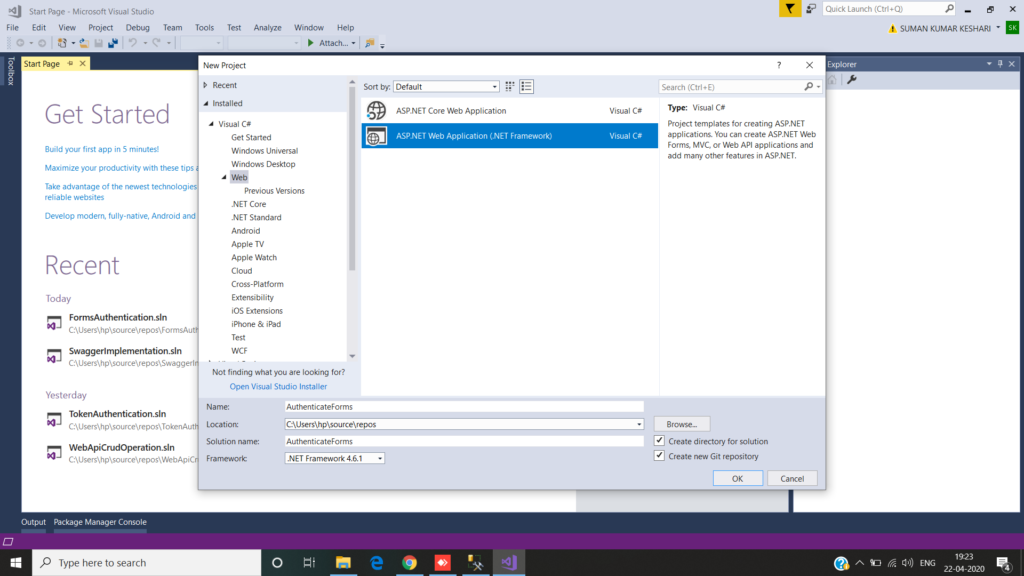
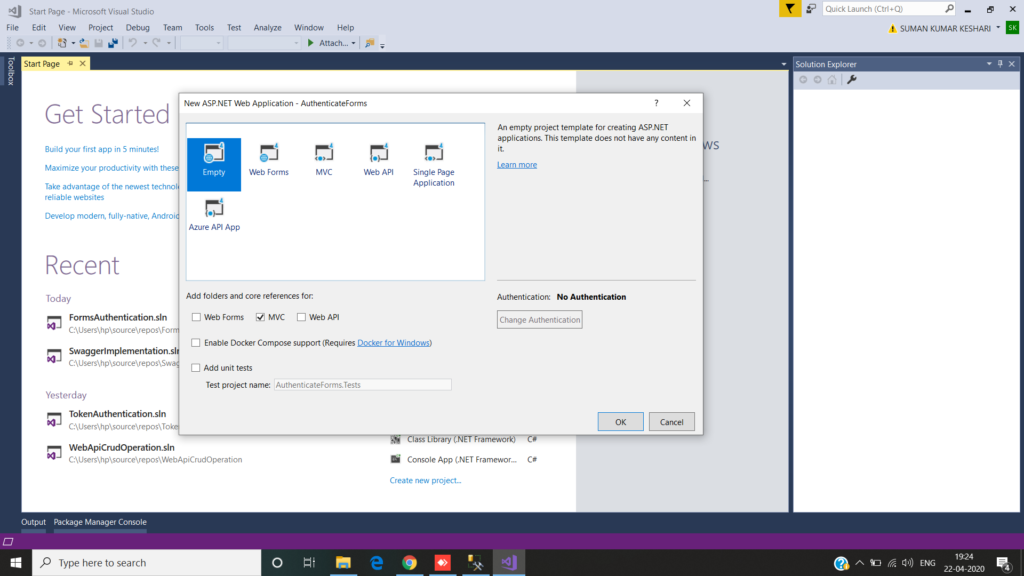
Step :2 Create a Database
-- Creating a database
CREATE DATABASE FormAuthentication_DB
GO
USE FormAuthentication_DB
GO
-- Creating Employee table
CREATE TABLE Employee
(
ID INT PRIMARY KEY IDENTITY(1,1),
Name VARCHAR(50),
Designation VARCHAR(50),
Salary INT
)
-- Creating Users table
CREATE TABLE Users
(
ID INT PRIMARY KEY IDENTITY(1,1),
UserName VARCHAR(50),
UserPassword VARCHAR(50)
)
-- Creating RoleMaster Table
CREATE TABLE RoleMaster
(
ID INT PRIMARY KEY IDENTITY(1,1),
RollName VARCHAR(50)
)
-- Creating User Roles Mapping table
CREATE TABLE UserRolesMapping
(
ID INT PRIMARY KEY,
UserID INT NOT NULL,
RoleID INT NOT NULL,
)
-- Adding Foreign KeyS
ALTER TABLE UserRolesMapping
ADD FOREIGN KEY (UserID) REFERENCES Users(ID);
ALTER TABLE UserRolesMapping
ADD FOREIGN KEY (RoleID) REFERENCES RoleMaster(ID);Step 3: Creating the ADO.NET Entity Data Model
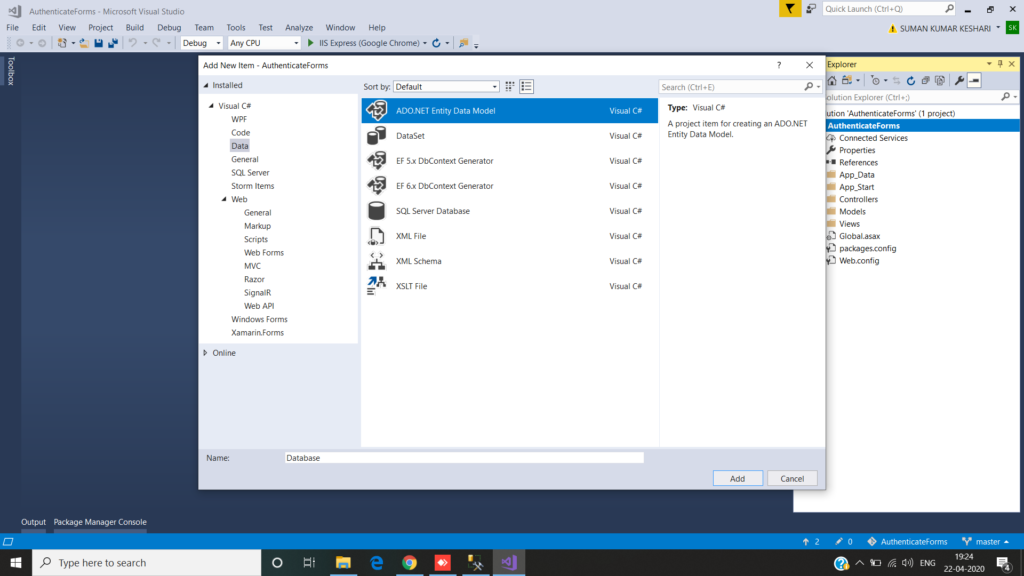
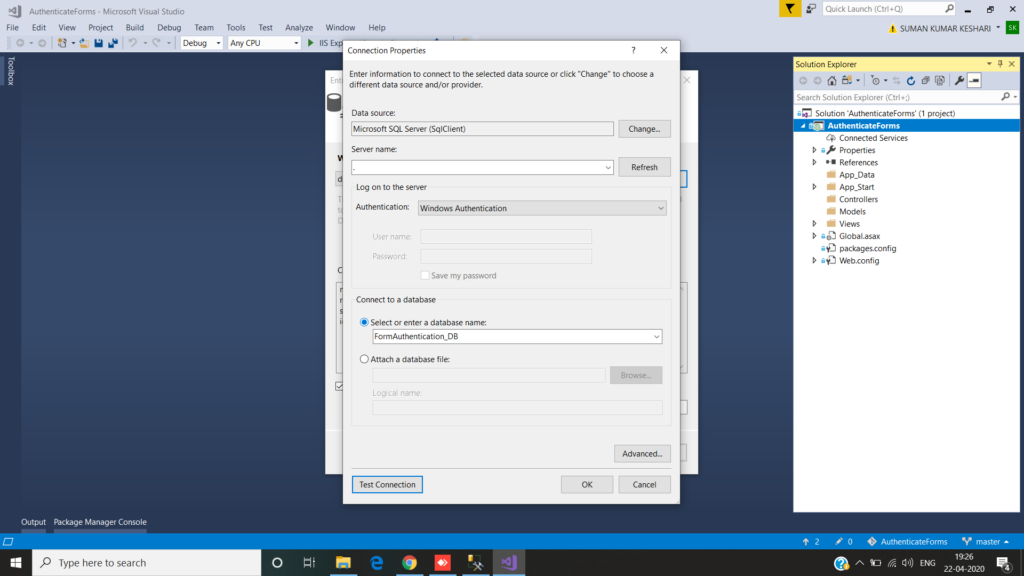
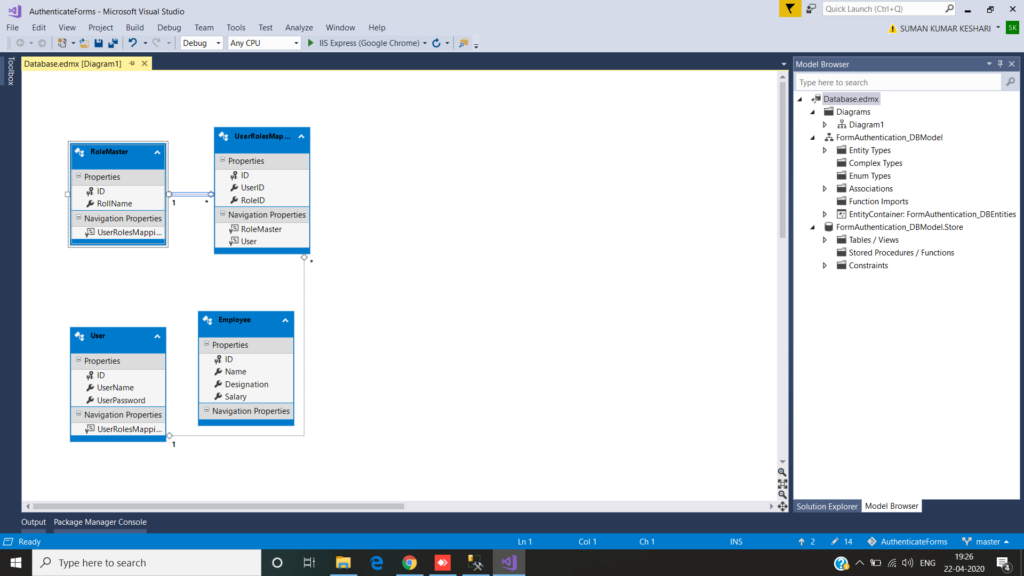
Step 4: Creating Employees Controller
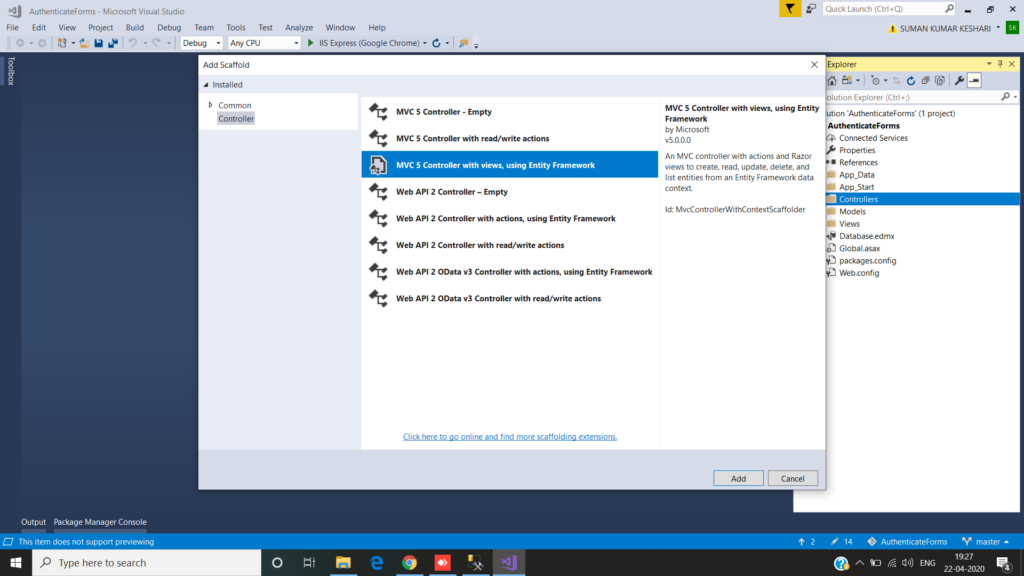
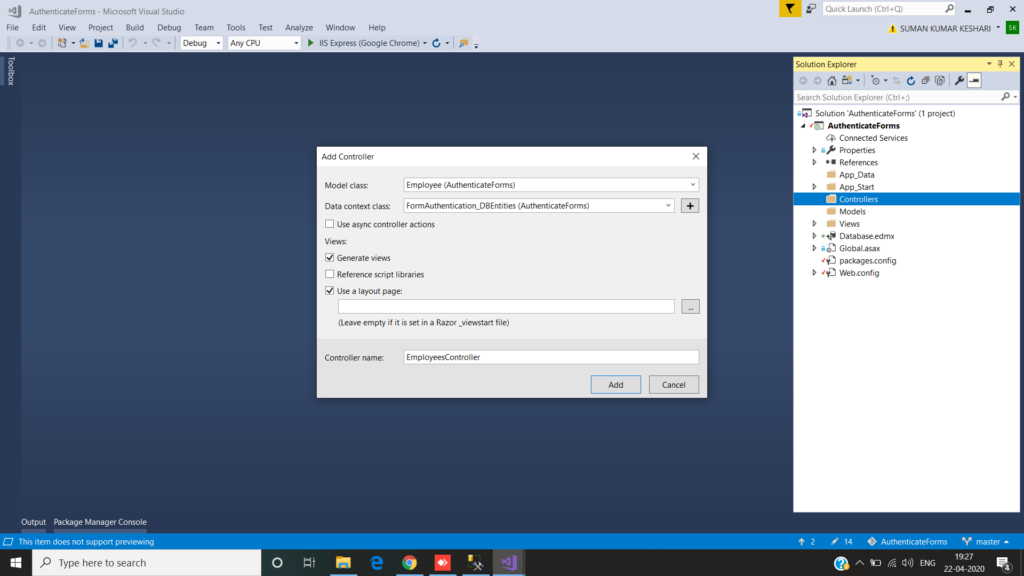
Here we select the MVC 5 Controller with Views, using Entity framework option to create the controller as shown above.
As you can see in the above image, you need to select the Model class as Employee and the Context class as FormAuthentication_DBEntities. Provide the controller name as EmployeesController and then click on the Add button which will create the EmployeesController.
Now the employee controller is created with the required action methods and views to perform the CRUD operation against the Employee entity.
Now, the above application is accessible to each and everyone without any restrictions. Now we need to provide security to this application. So the user with proper credentials can only be able to access our application. To achieve this we are going to use the Forms Authentication.
Implementing Forms Authentication in MVC:
The Forms Authentication is available in System.Web.Security namespace. In order to implement the Forms Authentication in MVC application, we need to do the following three things
- Set the Authentication mode as Forms in the web.config file
- We need to use FormsAuthentication.SetAuthCookie for login
- Again we need to use FormAuthentication.SignOut for logout
We are going to create another controller with the name Accounts to manage the user Signup, Sign in and log out functionalities.
Step 6: Creating Accounts Controller and then Add a new Class of UserModel for SIgn Up and Login.
using System;
using System.Collections.Generic;
using System.Linq;
using System.Web;
namespace AuthenticateForms.Models
{
public class UserModel
{
public int ID { get; set; }
public string UserName { get; set; }
public string UserPassword { get; set; }
}
}Step 7: Modifying the RouteConfig class
using System;
using System.Collections.Generic;
using System.Linq;
using System.Web;
using System.Web.Mvc;
using System.Web.Routing;
namespace AuthenticateForms
{
public class RouteConfig
{
public static void RegisterRoutes(RouteCollection routes)
{
routes.IgnoreRoute("{resource}.axd/{*pathInfo}");
routes.MapRoute(
name: "Default",
url: "{controller}/{action}/{id}",
defaults: new { controller = "Employees", action = "Index", id = UrlParameter.Optional }
);
}
}
}
Step 8: Then Add Authorize Attribute in the Employee Controller
[Authorize]
public class EmployeesController : ControllerStep 9: Then Implement the Login Sign Up and Sign Out Functionality
using AuthenticateForms.Models;
using System;
using System.Collections.Generic;
using System.Linq;
using System.Web;
using System.Web.Mvc;
using System.Web.Security;
namespace AuthenticateForms.Controllers
{
public class AccountsController : Controller
{
// GET: Accounts
public ActionResult Login()
{
return View();
}
[HttpPost]
public ActionResult Login(UserModel model)
{
using (FormAuthentication_DBEntities context = new FormAuthentication_DBEntities())
{
bool IsValidUser = context.Users.Any(user => user.UserName.ToLower() ==
model.UserName.ToLower() && user.UserPassword == model.UserPassword);
if (IsValidUser)
{
FormsAuthentication.SetAuthCookie(model.UserName, false);
return RedirectToAction("Index", "Employees");
}
ModelState.AddModelError("", "invalid Username or Password");
return View();
}
}
public ActionResult Signup()
{
return View();
}
[HttpPost]
public ActionResult Signup(User model)
{
using (FormAuthentication_DBEntities context = new FormAuthentication_DBEntities())
{
context.Users.Add(model);
context.SaveChanges();
}
return RedirectToAction("Login");
}
public ActionResult Logout()
{
FormsAuthentication.SignOut();
return RedirectToAction("Login");
}
}
}Login View
@model AuthenticateForms.Models.UserModel
@{
ViewBag.Title = "Login";
}
<h2>Login</h2>
@using (Html.BeginForm())
{
@Html.AntiForgeryToken()
<div class="form-horizontal">
<hr />
@Html.ValidationSummary(true, "", new { @class = "text-danger" })
<div class="form-group">
@Html.LabelFor(model => model.UserName, htmlAttributes: new { @class = "control-label col-md-2" })
<div class="col-md-10">
@Html.TextBoxFor(model => model.UserName, new { htmlAttributes = new { @class = "form-control" } })
@Html.ValidationMessageFor(model => model.UserName, "", new { @class = "text-danger" })
</div>
</div>
<div class="form-group">
@Html.Label("Password", htmlAttributes: new { @class = "control-label col-md-2" })
<div class="col-md-10">
@Html.TextBoxFor(model => model.UserPassword, new { htmlAttributes = new { @class = "form-control" } })
@Html.ValidationMessageFor(model => model.UserPassword, "", new { @class = "text-danger" })
</div>
</div>
<div class="form-group">
<div class="col-md-offset-2 col-md-10">
<input type="submit" value="Login" class="btn btn-default" />
</div>
</div>
</div>
}
<div>
@Html.ActionLink("Click here to Signup", "Signup")
</div>Sign Up View
@model AuthenticateForms.Models.UserModel
@{
ViewBag.Title = "Signup";
}
<h2>Signup</h2>
@using (Html.BeginForm())
{
@Html.AntiForgeryToken()
<div class="form-horizontal">
<hr />
@Html.ValidationSummary(true, "", new { @class = "text-danger" })
<div class="form-group">
@Html.LabelFor(model => model.UserName, htmlAttributes: new { @class = "control-label col-md-2" })
<div class="col-md-10">
@Html.TextBoxFor(model => model.UserName, new { htmlAttributes = new { @class = "form-control" } })
@Html.ValidationMessageFor(model => model.UserName, "", new { @class = "text-danger" })
</div>
</div>
<div class="form-group">
@Html.Label("Password", htmlAttributes: new { @class = "control-label col-md-2" })
<div class="col-md-10">
@Html.PasswordFor(model => model.UserPassword, new { htmlAttributes = new { @class = "form-control" } })
@Html.ValidationMessageFor(model => model.UserPassword, "", new { @class = "text-danger" })
</div>
</div>
<div class="form-group">
<div class="col-md-offset-2 col-md-10">
<input type="submit" value="Signup" class="btn btn-default" />
</div>
</div>
</div>
}
<div>
@Html.ActionLink("Click here to Login", "Login")
</div>After doing all the Above steps we are going to change the _layout.cshtml which is present in the Views/Shared Folder.
<!DOCTYPE html>
<html>
<head>
<meta charset="utf-8" />
<meta name="viewport" content="width=device-width, initial-scale=1.0">
<title>@ViewBag.Title - My ASP.NET Application</title>
<link href="~/Content/Site.css" rel="stylesheet" type="text/css" />
<link href="~/Content/bootstrap.min.css" rel="stylesheet" type="text/css" />
<script src="~/Scripts/modernizr-2.6.2.js"></script>
</head>
<body>
<div class="navbar navbar-inverse navbar-fixed-top">
<div class="container">
<div class="navbar-header">
<button type="button" class="navbar-toggle" data-toggle="collapse" data-target=".navbar-collapse">
<span class="icon-bar"></span>
<span class="icon-bar"></span>
<span class="icon-bar"></span>
</button>
@Html.ActionLink("Employee Portal", "Index", "Employees", new { area = "" }, new { @class = "navbar-brand" })
</div>
<div class="navbar-collapse collapse">
<ul class="nav navbar-nav">
@if (User.Identity.IsAuthenticated)
{
<li>@Html.ActionLink("Get Employee List", "Index", "Employees")</li>
<li>@Html.ActionLink("Add Employee", "Create", "Employees")</li>
<li><a>Hello - @User.Identity.Name</a></li>
<li>@Html.ActionLink("Logout", "Logout", "Accounts")</li>
}
else
{
<li>@Html.ActionLink("Login", "Login", "Accounts")</li>
}
</ul>
</div>
</div>
</div>
<div class="container body-content">
@RenderBody()
<hr />
<footer>
<p>© @DateTime.Now.Year - My ASP.NET Application</p>
</footer>
</div>
<script src="~/Scripts/jquery-1.10.2.min.js"></script>
<script src="~/Scripts/bootstrap.min.js"></script>
</body>
</html>The User.Identity.IsAuthenticated property returns true if the user is authenticated and the User.Identity.Name property returns the name of the authenticated user which we provide to the SetAuthCookie method which we implement in the Login Post method of Accounts Controller.
Now run the project and see how it works. As we know we set the default route parameter like i change the default controller name Employees and i also set Authorize parameter attribute so if we run the project then it automatically redirects to the Login Page due to the forms authentication. So first you have to sign up and then login with that credentials so you can access the Employees controller functionality.
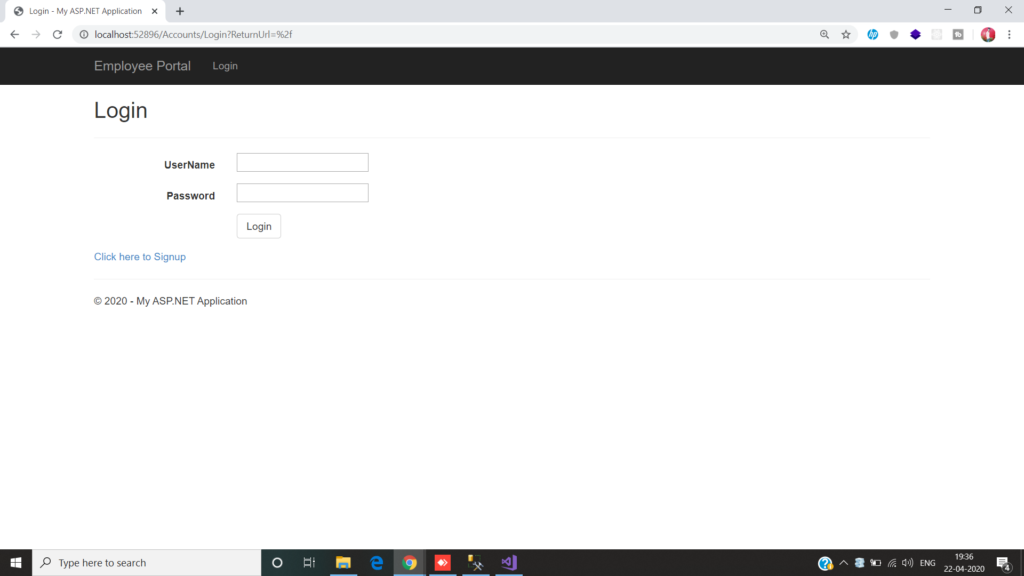
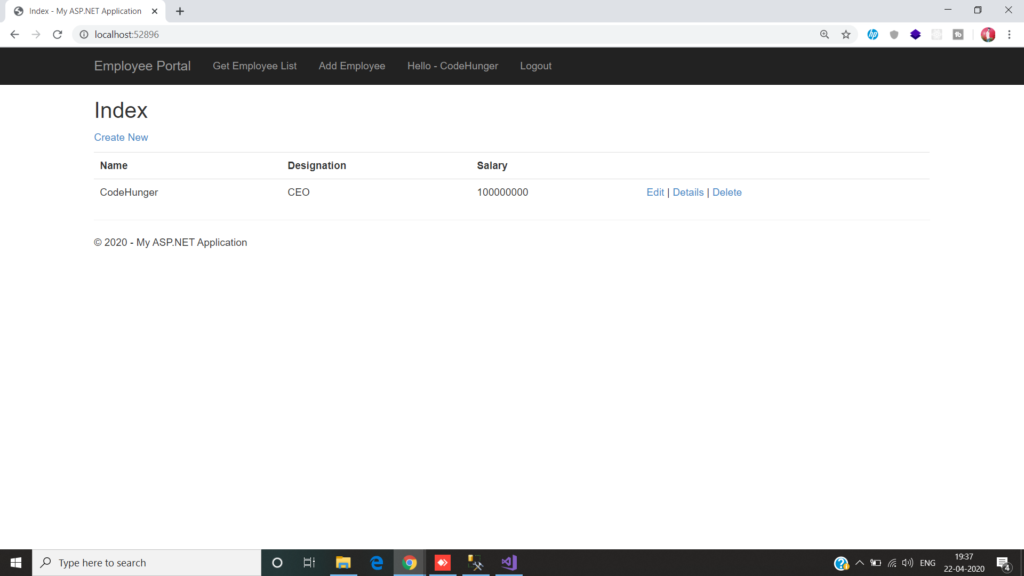
I hope you understand the above topic that how we can use FormAuthentication in a Asp.Net MVC project. If you have any query then feel free to ask in the comment section.





